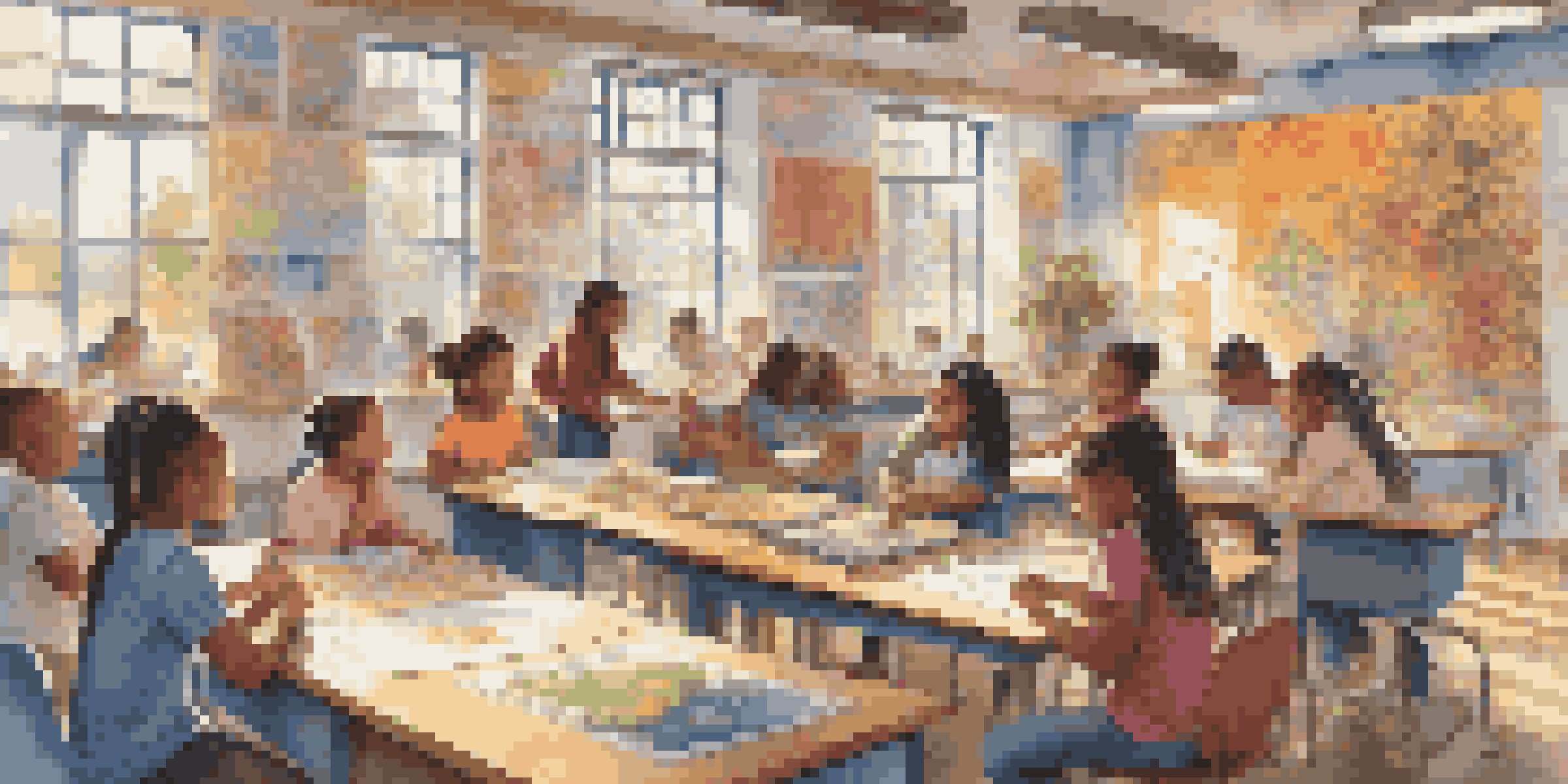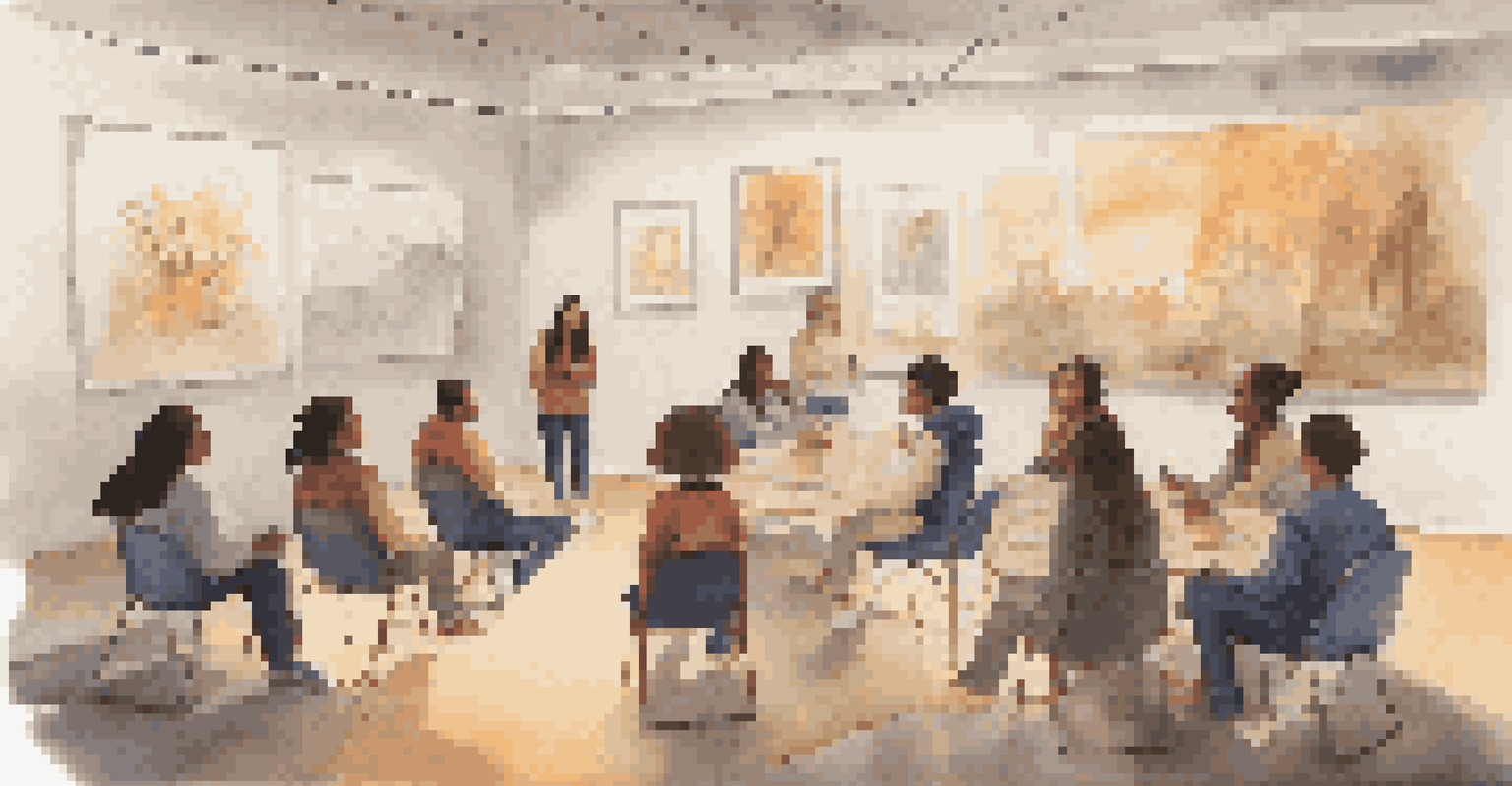Art Education's Impact on Developing Empathy in Students

Understanding Empathy and Its Importance in Education
Empathy is the ability to understand and share the feelings of others. In education, fostering empathy helps create a supportive learning environment where students feel valued and understood. This emotional connection can lead to better collaboration among peers and a more engaged classroom atmosphere.
Empathy is about finding echoes of another person in yourself.
When students practice empathy, they learn to appreciate diverse perspectives, which is crucial in today’s globalized world. By understanding different viewpoints, students can develop stronger interpersonal skills and become more compassionate individuals. This foundation is essential not just for personal growth but also for fostering a harmonious society.
Art education serves as a unique platform for cultivating empathy, as it encourages students to explore emotions and experiences that may differ from their own. Through various forms of artistic expression, they can connect with the stories and feelings of others, thus enhancing their understanding and empathy.
The Role of Art in Promoting Emotional Expression
Art provides a safe space for students to express their emotions authentically. Whether it’s through painting, music, or drama, students can explore their feelings and those of others, leading to greater self-awareness and empathy. This process allows them to articulate emotions that they might struggle to express verbally.

For instance, a student creating a piece of art based on personal experiences can invite their classmates to interpret it, fostering discussions about feelings and perspectives. These interactions encourage students to listen actively and relate to one another’s experiences, deepening their empathetic responses.
Empathy Enhances Learning Environments
Fostering empathy in education creates supportive classrooms where students feel valued and understood.
Furthermore, engaging with art can also spark conversations about challenging topics, helping students to navigate complex emotions collectively. This shared exploration builds a community where empathy thrives, illustrating the profound impact art can have on emotional development.
Experiencing Diversity Through Artistic Collaboration
Collaboration in art projects often brings together students from diverse backgrounds, creating opportunities for shared experiences. When students work together on a mural or a performance, they learn to appreciate each other's unique contributions, fostering a sense of belonging and teamwork. This diversity enriches their understanding of various cultures and perspectives.
The greatest gift of human beings is that we have the power of empathy.
Consider a classroom where students create a group sculpture using materials that represent their individual backgrounds. As they collaborate, they share stories and insights, which helps build a deeper connection and appreciation for one another. These experiences can significantly enhance their capacity for empathy.
Moreover, collaborative art projects encourage students to step outside their comfort zones and confront their biases. As they navigate these interactions, they develop critical social skills that empower them to engage empathetically with others in various settings.
Art as a Tool for Understanding Global Issues
Art education often includes discussions about global issues, encouraging students to reflect on real-world challenges. Through artistic exploration of themes such as poverty, discrimination, or environmental crises, students can engage with these topics on a deeper emotional level. This engagement fosters a sense of responsibility and prompts them to think critically about their role in society.
For example, a project centered around climate change might involve students creating visual art to convey their concerns. As they research and discuss the issue, they not only learn about its impact but also develop empathy for those affected by it. This understanding can inspire them to take action, demonstrating the power of art in social advocacy.
Art Encourages Emotional Expression
Engaging with art provides students a safe space to authentically express their emotions and connect with others.
By connecting art with global issues, educators can help students recognize their shared humanity and encourage them to become compassionate, active citizens. This holistic approach to learning reinforces the importance of empathy in addressing complex societal challenges.
Incorporating Storytelling in Art Education
Storytelling is a vital component of art education that enhances empathetic understanding. By sharing personal or cultural narratives through art, students can convey emotions and experiences that resonate with others. This practice not only enriches their artistic expression but also fosters connections with peers.
For instance, a student might create a visual story about their family's heritage, inviting classmates to share their stories in return. This exchange promotes empathetic listening and appreciation for the diversity of experiences within the classroom. Such storytelling can bridge gaps between students and cultivate a supportive community.
Additionally, storytelling through art can serve as a powerful tool for healing. Students confronting personal challenges can find solace in expressing their experiences, enabling them to process emotions while fostering empathy among their peers.
The Impact of Art Education on Mental Health
Engaging with art has been shown to have positive effects on mental health, which in turn enhances empathy. When students express themselves creatively, they often experience reduced stress and anxiety, leading to improved emotional well-being. This healthier emotional state allows them to connect with others more readily and empathetically.
A study may show that students involved in regular art classes report feeling more relaxed and open to sharing their feelings. As they cultivate their emotional intelligence through art, they become more attuned to the emotions of others, creating a ripple effect of empathy in their interactions.
Collaboration Builds Cultural Understanding
Artistic collaboration allows students from diverse backgrounds to share stories, enhancing empathy and teamwork.
Moreover, art education can serve as an outlet for students struggling with mental health challenges. By providing a means to express complex feelings, students can develop coping strategies and a greater understanding of their experiences, further enhancing their capacity for empathy.
Conclusion: Art Education as a Catalyst for Empathy
In conclusion, art education plays a crucial role in developing empathy among students. Through emotional expression, collaboration, and storytelling, students learn to appreciate and understand diverse perspectives. This journey not only enriches their artistic skills but also fosters a sense of community and social responsibility.
As educators and parents, recognizing the importance of art education can help nurture empathetic individuals who are equipped to navigate a complex world. Encouraging students to engage with art is not just about creativity; it’s about shaping compassionate future leaders.

Ultimately, by prioritizing art education in our schools, we can cultivate a generation of empathetic individuals who value connection, understanding, and kindness in their interactions with others.